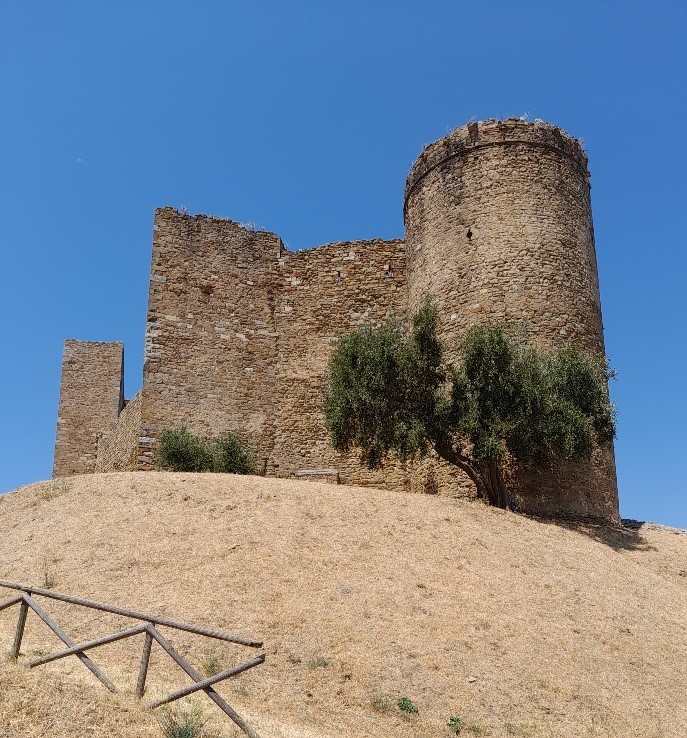ATTENZIONE: SI PREGA DI NASCONDERE IL CACHE DIETRO ALCUNI SASSI! ESSENDO PASSATI PIU' VOLTE PER UN CONTROLLO, ABBIAMO SEMPRE TROVATO IL CONTENITORE BEN VISIBILE AL PASSAGGIO!
GRAZIE!
ATTENTION: PLEASE HIDE THE CACHE BEHIND SOME STONES! EVERY TIME WE PASSED FOR A CHECK, WE HAVE ALWAYS FOUND THE CONTAINER WELL VISIBLE WHEN PASSING!
THANK YOU!

ITA
ROCCA DI SCARLINO
La sommità del colle che sovrasta il borgo di Scarlino è abitata sin dal X Sec. a.C.
Durante più di 3000 anni di storia il sito fu abitato ed utilizzato in modo diverso e cambiò il suo aspetto fino a trasformarsi nella Rocca che rimane ancora oggi.
Nell'Età del Bronzo (XII-X sec. a.C.) esisteva un villaggio di capanne di legno; in seguito gli Etruschi (IX-X sec. a.C.) realizzarono un centro di estrazione e lavorazione del ferro. I romani (III sec. a.C.) si trasferirono più a valle per poter costruire Ville più ampie. Con il Medioevo (dal VII sec. d.C.) sul colle le abitazioni costituirono un piccolo borgo agricolo con case di legno, chiesa, cinta muraria.
Nel 973 un documento cita per la prima volta il nome di Scarlino.
Intorno all'anno 1000 la Rocca assunse l'aspetto di un vero e proprio castello signorile (proprietà della famiglia Aldobrandeschi).
Nel 1276-77 il colle viene venduto alla città di Pisa (per questo la Rocca viene chiamata anche "Pisana") che costruisce il castello come segno di controllo sul borgo e sul golfo.
La Rocca diviene quindi una fortezza militare attiva per tutto il 1300.
In seguito diviene proprietà dei Signori di Piombino (Appiani) e nel '400 il paese viene ingrandito. Intorno alla Rocca vengono aggiunti un fossato e una seconda cinta di mura.
Nel 1815 Scarlino e la Rocca passano dal Principato di Piombino alla giurisdizione del Granducato di Toscana.
Negli anni in seguito il castello venne abbandonato fino al 1979, quando l'Università di Siena effettuò lavori di scavo e recupero conclusisi nel 1983, che hanno permesso di documentare 3000 anni di storia.
Tra i ritrovamenti spicca il "Tesoro della Rocca", una collezione di 100 monete d'oro risalenti all'inizio del 1300 ritrovate in un vasetto nascosto in una nicchia della chiesa i cui resti sono ancora visibili sul colle.
Nel paese di Scarlino è presente un Museo con tutti i ritrovamenti delle varie epoche storiche.

RIGUARDO LA CACHE
La cache è nascosta all'esterno delle mura, nel parco della Rocca, in quanto l'ingresso è a pagamento e quindi in alcuni orari chiuso (vedi foto). Il parco è di libero accesso, si cammina tra ulivi secolari e resti di mura romane autentiche, si prega di trattare entrambi con rispetto!

ENG
SCARLINO FORTRESS
The top of the hill overlooking the village of Scarlino has been inhabited since the 10th century BC.
During more than 3000 years of history the site was inhabited and used in different ways and changed its appearance until it became the fortress that still remains today.
In the Bronze Age (XII-X century BC) there was a village of wooden huts; later the Etruscans (IX-X century BC) built an iron extraction and processing center. The Romans (III century BC) moved further downstream to be able to build larger villas. With the Middle Ages (from the 7th century AD) on the hill the houses formed a small inhabited agricultural village with wooden houses, church, walls.
In 973 a document mentions the name of Scarlino for the first time. Around the year 1000 the Rocca took on the appearance of a real noble castle (property of the Aldobrandeschi family).
In 1276-77 the hill was sold to the city of Pisa (for this reason the Rocca is also called "Pisana") who built the castle as a sign of control over the village and the gulf. The Rocca then became a military fortress active throughout the 1300s.
Later it became the property of the Lords of Piombino (Appiani) and in the 15th century the town was enlarged. A moat and a second surrounding wall were added around the fortress.
In 1815 Scarlino and the Rocca passed from the Principality of Piombino to the jurisdiction of the Grand Duchy of Tuscany.
In the following years the castle was abandoned until 1979, when the University of Siena carried out excavation and recovery works which ended in 1983, which allowed to document 3000 years of history.
Among the finds stands out the "Tesoro della Rocca", a collection of 100 gold coins dating back to the early 1300s found in a jar hidden in a niche of the church (whose remains are still visible on the hill).
In centre of Scarlino there is a museum with all the finds from the various historical periods.

ABOUT THE CACHE
The cache is hidden outside the Rocca walls, in the park, as the entrance is subject to a fee and therefore closed at certain times (see photo). The park is free to access, you walk among centuries-old olive trees and the remains of authentic Roman walls, please treat both with respect!